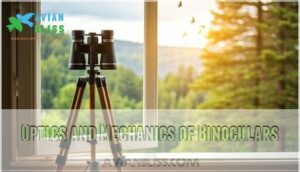This site is supported by our readers. We may earn a commission, at no cost to you, if you purchase through links.

The 8×32 configuration hits the sweet spot—delivering a 4mm exit pupil that matches your eye’s natural pupil diameter while maintaining excellent portability.
Higher magnifications like 10x amplify hand tremors and shrink your field of view from 350 feet to just 315 feet at 1,000 yards.
Meanwhile, larger apertures (42mm-50mm) boost brightness but add significant weight.
The magic happens when exit pupil diameter (aperture ÷ magnification) aligns with your viewing conditions—smaller pupils work fine in daylight, but low-light scenarios demand those precious extra millimeters of light transmission.
Table Of Contents
- Key Takeaways
- What is The Best Aperture for Binoculars?
- What is a Good Magnification Level for Binoculars?
- 10×50 Vs. 20×50 Binoculars
- Comparison: 8×21 Vs. 10×25 Binoculars
- Optics and Mechanics of Binoculars
- Frequently Asked Questions (FAQs)
- What is the best aperture for binoculars?
- What is a good magnification level for binoculars?
- What is better, 10×50 or 20×50?
- Which binoculars are better, 8×21 or 10×25?
- How does eye relief impact binocular comfort?
- Why is a wider field of view beneficial?
- What are the pros and cons of Porro prisms?
- How does coating type affect light transmission?
- What is the importance of exit pupil diameter?
- How does exit pupil size affect viewing quality?
- Conclusion
Key Takeaways
- You’ll get the best balance with 8×32 binoculars—they deliver a 4mm exit pupil that matches your eye’s natural diameter while staying lightweight for extended use.
- Don’t choose 10x magnification unless you need extreme detail—it amplifies hand tremors, shrinks your field of view from 350 to 315 feet, and makes tracking moving subjects much harder.
- Calculate exit pupil diameter by dividing aperture by magnification—larger exit pupils (4-7mm) provide brighter images in low-light conditions, while smaller ones work fine in daylight.
- Larger apertures (42-50mm) gather more light for clearer images but add significant weight—choose 32mm for portability or 42mm when brightness trumps convenience.
What is The Best Aperture for Binoculars?
You’ll find that aperture size directly impacts your binocular’s light-gathering ability, with larger objective lenses delivering brighter images in dim conditions.
The ideal aperture balances brightness with portability, as bigger lenses mean heavier binoculars that can strain your neck during extended use.
Objective Lens Size
When you’re choosing between aperture sizes, the lens diameter fundamentally determines your binoculars’ light gathering capability and optical quality.
Bigger lenses capture more light, delivering clearer images when conditions get tough
Larger objective lenses capture more photons, delivering superior image clarity and focus distance performance.
Consider these key factors for objective lens size selection:
- 32mm apertures balance portability with adequate light gathering for daytime use
- 42mm lenses excel in low-light conditions but increase weight substantially
- 50mm+ diameters maximize image quality while sacrificing portability for serious applications
Understanding the benefits of 32mm binoculars can help you make a more informed decision.
Your magnification power and aperture binoculars choice should match your specific viewing needs and carrying preferences.
8×32 Binoculars for Brightness and Portability
When you’re hunting for that sweet spot between image brightness and portability, 8×32 aperture binoculars deliver perfectly balanced performance.
The 32mm lens aperture captures sufficient light for clear image quality, while 8x magnification power maintains generous field width for easy tracking.
These hand held units won’t fatigue your arms during extended sessions. Quality lens coating and comfortable eye relief complete this winning combination for serious outdoor enthusiasts.
For ideal viewing, consider the benefits of high quality optics in your binocular selection.
10x Binoculars Not Recommended for Smaller Field of View
10x binoculars create unnecessary viewing challenges that’ll frustrate your outdoor adventures.
Higher magnification power amplifies hand tremors, reducing image stability substantially.
Field of view shrinks from approximately 350 feet to 315 feet at 1,000 yards compared to 8x models.
Consider these field limits with high power binoculars:
- Magnification effects reduce tracking ability – Moving subjects become harder to follow
- Eye relief decreases comfort – Especially problematic for eyeglass wearers
- Binocular balance suffers – Heavier optics cause fatigue during extended use
- Binocular magnification above 8x demands steadier hands – Image shake increases dramatically
Smart buyers choose 8×32 configurations for superior field of view and practical magnification numbers that enhance rather than hinder your viewing experience.
What is a Good Magnification Level for Binoculars?
Choosing the right magnification level directly impacts your viewing experience and determines how stable your image will be.
You’ll find that 8x magnification offers the best balance between bringing subjects closer and maintaining a steady, bright image that’s easy to use.
Magnification Power
Magnification power determines how many times larger objects appear compared to your naked eye view.
An 8x magnification brings subjects eight times closer, while 10x magnification delivers even greater zoom capacity but introduces trade-offs you’ll want to weigh.
High magnification above 10x creates significant image stability challenges.
Your natural hand movements become amplified, causing noticeable shake that makes tracking difficult.
Think of it like holding a telescope – the more you zoom in, the shakier everything gets.
Magnification numbers also create power limits for handheld use.
Most experts recommend staying between 7x-10x for ideal performance without tripod support.
Beyond 12x, you’ll need stabilization equipment to maintain steady viewing.
The field reduction effect means higher magnification power and aperture combinations narrow your viewing window, making it harder to locate and follow moving targets like birds or wildlife.
Effect on Field of View and Brightness
Understanding magnification power’s impact helps you choose binoculars that match your viewing needs.
Higher magnification reduces field of view and image brightness substantially. The exit pupil diameter affects viewing comfort in different lighting conditions.
Higher magnification sacrifices brightness and field width for closer detail – choose wisely based on your viewing priorities
Key Magnification Effects on viewing performance:
- Field Size – 8x binoculars show 350 feet at 1,000 yards versus 10x showing 315 feet
- Image Brightness – Higher magnification darkens images, especially in low light
- Viewing Comfort – Increased magnification amplifies hand shake and reduces stability
- Lens Quality – Multi-coatings become more critical with higher aperture combinations
Recommendation for General Use
For most users, 8x magnification strikes the perfect balance between optical zoom and practical field view.
This Magnification Guide recommendation delivers exceptional image quality without sacrificing image stability that plagues higher magnification power settings.
Key advantages of 8x binoculars for general use:
- Optimal eye relief – Comfortable viewing for extended periods, even with glasses
- Superior field view – Wider coverage makes tracking moving subjects effortless
- Enhanced image stability – Reduced hand shake compared to 10x+ Binocular Types
- Versatile aperture compatibility – Works excellently with 32mm-42mm objective lenses
- All-weather durability – Most quality 8x models feature waterproof binoculars construction
Understanding the right magnification power is vital for an ideal bird watching experience.
10×50 Vs. 20×50 Binoculars
Power defines the battleground between clarity and detail when comparing 10×50 versus 20×50 binoculars. The choice hinges on your specific viewing goals and comfort requirements.
10×50 binoculars deliver superior Image Stability with their moderate magnification power. The 50mm aperture provides excellent light gathering, creating a 5mm exit pupil that matches your eye’s natural dilation in darkness. You’ll enjoy brighter images and easier handheld use.
20×50 binoculars offer High Power magnification for distant subjects but demand sacrifices. The identical aperture yields only a 2.5mm exit pupil, reducing brightness considerably. Magnification Effects include pronounced hand shake and narrower field of view, typically requiring tripod mounting.
Optical Quality depends heavily on Binocular Design stability. While 20x reveals finer details, the practical advantages of 10x make it the versatile champion for most applications. Understanding binocular specifications is vital for making an informed decision.
| Feature | 10×50 | 20×50 |
|---|---|---|
| Exit Pupil | 5mm (bright) | 2.5mm (dim) |
| Stability | Handheld capable | Tripod required |
| Field of View | 315 feet/1000 yards | 158 feet/1000 yards |
Comparison: 8×21 Vs. 10×25 Binoculars
When choosing between 8×21 and 10×25 binoculars, you’re comparing two compact models with distinct trade-offs in magnification, light gathering, and portability.
The 8×21 offers a wider 350-foot field of view at 1,000 yards compared to the 10×25’s narrower 315-foot view.
The 10×25 provides 25% more magnification power and a slightly larger 2.5mm exit pupil versus the 8×21’s 2.6mm exit pupil, which affects the portability.
Field of View, Brightness, and Portability
When choosing between these compact models, you’ll notice distinct performance differences that matter for your viewing experience.
Key Performance Factors:
| Feature | 8×21 | 10×25 |
|---|---|---|
| Field Width | 367 feet at 1,000 yards | 288 feet at 1,000 yards |
| Image Brightness | 2.6mm exit pupil | 2.5mm exit pupil |
| Portability | 8.5 oz average | 10.2 oz average |
| Eye Relief | 11-13mm | 13-15mm |
The 8×21’s wider field of view makes tracking subjects easier, while its slightly larger exit pupil delivers marginally better low light performance.
However, the 10×25’s superior magnification power brings distant objects closer with better image stability due to its larger aperture.
Both models sacrifice lens quality compared to full-size binoculars, but they’re perfect for travel when portability trumps optical excellence.
For outdoor enthusiasts, understanding compact binoculars features is essential for making informed purchasing decisions.
Suitable Uses and Limitations
Both configurations have distinct strengths depending on your viewing goals.
The 8×21 shines when portability factors matter most—you’ll appreciate its pocket-friendly design during long hikes or travel.
However, low light viewing becomes challenging due to the smaller 2.6mm exit pupil.
The 10×25 offers better magnification power for long range viewing, though image stability requires steadier hands.
Eye relief typically measures 10-15mm on both models, adequate for most users.
When considering binoculars for birding, understanding the difference in magnification power is essential for making an informed decision.
| Use Case | 8×21 Best For | 10×25 Best For |
|---|---|---|
| Primary Activity | Hiking, concerts, sports events | Wildlife observation, distant subjects |
| Lighting Conditions | Bright daylight only | Moderate light with limitations |
| Field Sizes | Wide scanning, fast-moving targets | Detailed examination, stationary objects |
| Image Stabilization | Hand-holdable, less shake | Requires steadier grip or support |
Choose 8×21 for maximum portability; select 10×25 when magnification power trumps field of view considerations.
Optics and Mechanics of Binoculars
Understanding the internal mechanics of your binoculars helps you make smarter purchasing decisions and get better performance in the field.
The prism system, lens coatings, and optical design directly affect image quality, brightness, and durability for your specific viewing needs, which is crucial for better performance.
Prism Systems: Porro, Roof, Schmidt-Pechan
The prism system determines your binocular’s size, weight, and optical performance.
Porro prism designs use Z-shaped configurations that deliver brighter images with excellent depth perception but create bulkier bodies.
Roof prisms offer compact, lightweight construction through straight-line optical paths, though they require specialized coatings to match Porro brightness.
Schmidt-Pechan prisms, the most common roof variant, balance portability with performance using advanced mirror coatings.
While Porro systems excel in light transmission and cost-effectiveness, roof prism designs dominate modern premium markets due to their durability and weather-sealing capabilities, making prism alignment and optical quality vital factors in your selection.
The choice of binoculars often depends on understanding prism design basics to verify the best optical performance for specific needs.
Coating Types: Broadband Multi-coating, Multi-coating, Fully Multi-coated
Lens coating transforms optical quality by controlling light transmission through antireflection coatings.
Different coating materials deliver varying performance levels:
- Broadband multicoating: Achieves 95%+ light transmission across wide spectrum, superior optical quality
- Fully multicoated: Covers all air-to-glass surfaces, delivers 90-95% light transmission efficiency
- Multicoating: Multiple layers on select surfaces, provides 80-90% light transmission
- Standard coatings: Basic reflective coatings reduction, budget-friendly option
- Uncoated lenses: Minimal light transmission, significant reflections and glare
Choose coatings quality matching your viewing conditions and budget requirements.
Suitable Binoculars for Different Activities
Match your binoculars to your adventure.
Bird watching thrives with 8×32 models offering wide field of view and portable design.
Wildlife viewing demands 10×42 configurations for enhanced magnification power and superior image quality.
Hiking gear benefits from compact 8×25 options balancing weight and performance.
Astronomy tools require larger aperture designs like 10×50 for maximum light gathering and detail resolution in outdoor binoculars applications.
When choosing the right binoculars, consider the importance of optical quality factors to guarantee a great viewing experience, and check optical quality factors for more information on great viewing.
Frequently Asked Questions (FAQs)
What is the best aperture for binoculars?
Like a window to distant worlds, your aperture choice reveals clarity. You’ll want 32-42mm for ideal balance—32mm stays portable while 42mm gathers maximum light for dawn adventures.
What is a good magnification level for binoculars?
For general use, 8x magnification strikes the perfect balance—you’ll get close-up views without the shaky images that plague higher powers.
It maintains a wide field of view for tracking moving subjects effortlessly.
What is better, 10×50 or 20×50?
Choose 10×50 for better tracking and steadier images.
You’ll maintain a wider field of view while gathering excellent light.
The 20×50’s extreme magnification creates shaky, narrow views that’ll frustrate you during active observation sessions, making 10×50 a better option for steadier images.
Which binoculars are better, 8×21 or 10×25?
Yonder 8×21 binoculars outshine 10×25 models for most adventures.
You’ll get steadier images with wider field-of-view at 8x magnification, though both compact models struggle in low-light conditions due to their small apertures.
How does eye relief impact binocular comfort?
Eye relief determines how far you can hold binoculars from your eyes while maintaining the complete field of view.
If you wear glasses, you’ll need at least 15mm eye relief for comfortable viewing without removing your eyewear.
Why is a wider field of view beneficial?
A wider field of view lets you track fast-moving birds and spot subjects easier.
You’ll see more of the landscape at once, making it simpler to navigate and follow action without constantly readjusting your binoculars.
What are the pros and cons of Porro prisms?
Porro prisms deliver brighter, sharper images with superior depth perception and wider spacing between objective lenses.
However, they’re bulkier, heavier, and more fragile than roof prism designs, making them less portable for extended outdoor adventures.
How does coating type affect light transmission?
Lens coatings dramatically boost your light transmission by reducing reflections that steal precious photons.
Anti-reflective coatings can increase transmission from 50% to over 90%, delivering brighter, clearer images with enhanced contrast and color fidelity, and thus providing clearer views.
What is the importance of exit pupil diameter?
Exit pupil diameter determines how much light reaches your eyes and affects image brightness.
Calculate it by dividing aperture by magnification.
Larger exit pupils (4-7mm) provide brighter images, especially essential for low-light viewing conditions.
How does exit pupil size affect viewing quality?
Larger exit pupils deliver brighter images by matching your eye’s natural pupil diameter. When exit pupil size exceeds your eye’s capability, you’re wasting light-gathering potential and carrying unnecessary weight.
Conclusion
When the rubber meets the road with magnification power aperture binoculars, your decision hinges on matching exit pupil diameter to your specific viewing conditions and activities.
The 8×32 configuration remains the gold standard for general use, delivering ideal brightness through its 4mm exit pupil while maintaining excellent portability.
Higher magnifications sacrifice field of view and introduce hand tremor amplification, while larger apertures add unwanted weight.
Calculate exit pupil diameter by dividing aperture by magnification, then select based on your primary use case and lighting conditions.
- https://binocularsguru.com/best-binoculars-for-hunting/
- https://www.celestron.com/blogs/knowledgebase/what-is-the-difference-between-roof-prism-and-porro-prism-binoculars
- https://moonandback.com/best-astronomy-binoculars/
- https://tractoptics.com/blog/8x32-binoculars-are-the-ideal-compact-optics/
- https://www.allaboutbirds.org/news/best-affordable-compact-binoculars-review/







